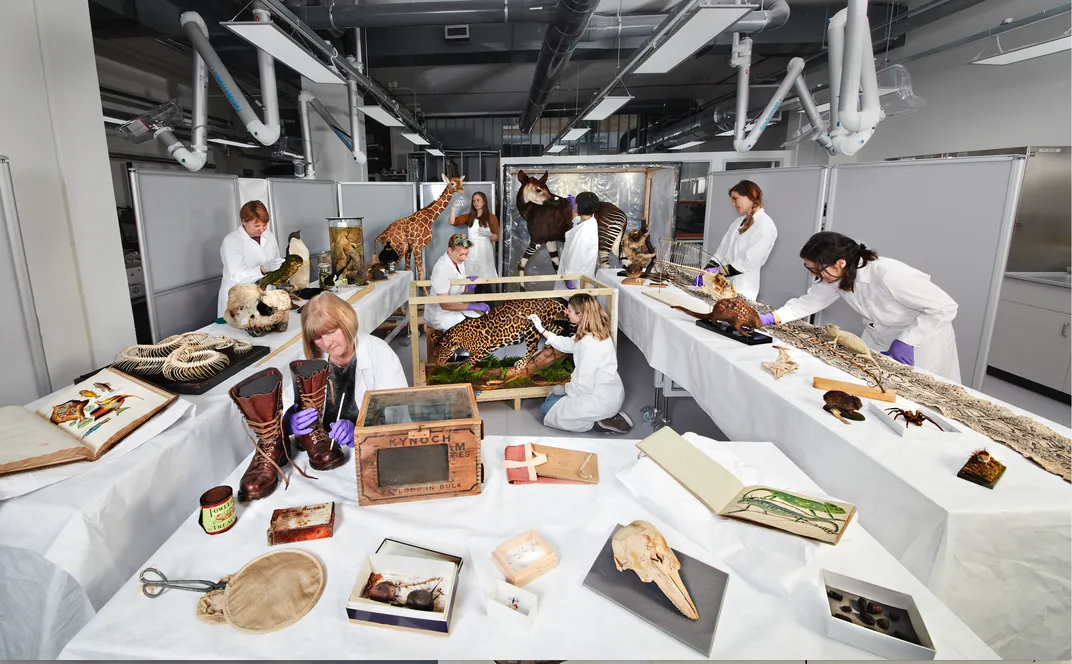Meet the Real Animals Behind Mermaids, Dragons and Other Mythical Creatures
You can now take a virtual tour of a “Harry Potter”–inspired exhibition exploring the origins of fantastical beings
:focal(977x660:978x661)/https://tf-cmsv2-smithsonianmag-media.s3.amazonaws.com/filer/89/13/8913f956-1cf3-4949-a46a-a126050a465c/screen_shot_2020-12-18_at_14607_pm.png)
Mermaids, sea serpents, manatees and giant oarfish may not appear to have much in common. But these creatures actually share a core characteristic: The first two are invented, while the latter are the real animals that inspired these imagined beings.
On view through summer 2021, a new exhibition at London’s Natural History Museum (NHM) traces the real-life origins of mythical creatures like the ones listed above. Titled “Fantastic Beasts: the Wonders of Nature,” the show draws inspiration from Fantastic Beasts and Where to Find Them, a 2016 Harry Potter spinoff that follows the journey of fictional wizard and “magizoologist” Newt Scamander (played by Eddie Redmayne).
Though the museum is closed right now due to the Covid-19 pandemic, viewers can tour highlights on the exhibition’s website or take an interactive tour of the space via Google Arts & Culture.
/https://tf-cmsv2-smithsonianmag-media.s3.amazonaws.com/filer/95/57/95575e6d-95f4-4f7b-acf3-dd292bf21038/screen_shot_2020-12-18_at_32646_pm.png)
In the show, the skull of a manatee hangs alongside the mythical creature that it inspired: a mermaid. Similar sightings of giant oarfish, giant squid and other undersea giants led early sailors to weave tales about sea serpents, the kraken and other beasts.
Many of Scamander’s magical companions, including replicas of Nifflers and Bowtruckles, make appearances in the exhibition, reports Jonathan Jones for the Guardian. Also featured is Dracorex hogwartsia, a 66-million-year-old dinosaur skull named after the fictional Hogwarts School of Witchcraft and Wizardry.
“Fantastic Beasts” offers visitors a moment to reflect on the museum’s own history: Its founder, Richard Owen, was a Victorian scientist nicknamed the “Sea Serpent Killer” in honor of his efforts to debunk myths about creatures lurking in the ocean’s murky depths. Many of his newspaper clippings appear in the exhibition, providing a glimpse into a not-too-distant past when tales of strange monsters weren’t too far-fetched to be believed.
As the show explains, some of the monsters that haunt modern imagination have roots in the medieval period, when they played complex roles in society. Individuals invented fantastical beasts to capture the imagination, reinforce power structures and demonize marginalized groups, among other purposes, according to the Morgan Library & Museum. For medieval Christians in particular, wrote historian Alixe Bovey in a 2015 British Library blog post, monsters and other strange creatures helped people articulate symbolic truths and imagine what lay beyond the bounds of their known world.
“Monsters were often used to define boundaries and to express a distinction between morality and sin—or conformity and nonconformity,” Bovey explained.
Groups perceived as enemies to Christendom—including Jews, Muslims and Tartars—were demonized as “physically deformed,” the historian added.
The London museum’s head of conservation, Lorrain Cornish, tells Forbes’ Emma Pocock that NHM wanted to emphasize the importance of conserving real-life creatures through a fresh, magical lens.
“We put a lot of effort into exploring those conservation stories and contrasting those with Newt’s own story, showing things like Newt’s last breeding pair of Graphorns, and real efforts to bring animals back from the brink, like the story of incredible efforts to save the Kākāpō, a flightless parrot, in New Zealand,” she says.
All told, notes NHM Executive Director of Engagement Clare Matterson in a statement, “Visitors will leave with a renewed love of the wonders of nature, and a revived urgency to help protect it.”
/https://tf-cmsv2-smithsonianmag-media.s3.amazonaws.com/accounts/headshot/nora.png)
/https://tf-cmsv2-smithsonianmag-media.s3.amazonaws.com/filer/25/7c/257cb23c-3808-43c5-a81c-7885f2df40ff/exhibition_panorama.jpg)
/https://tf-cmsv2-smithsonianmag-media.s3.amazonaws.com/filer/9f/ed/9fedae06-717b-4e04-b9a7-4a37b3e8d580/beast_newspaper.jpg)


/https://tf-cmsv2-smithsonianmag-media.s3.amazonaws.com/accounts/headshot/nora.png)